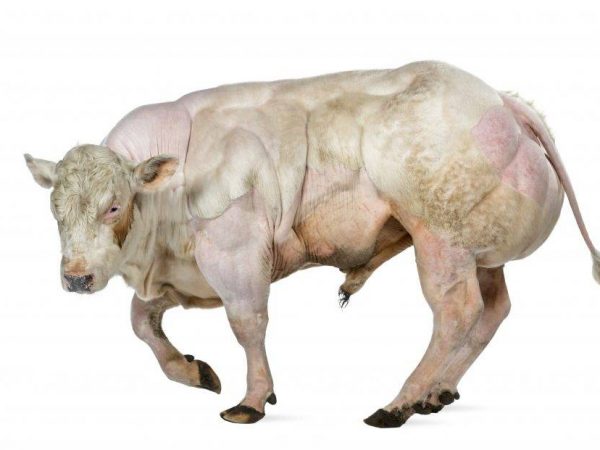Belgian blue cow
If you look at the photo of this representative of cattle, especially a bull, you will immediately notice a pile of muscles pumped up like a professional athlete. The Belgian blue cow has such a unique physique.

Belgian blue cow
About the blue breed from Belgium
The Belgian blue beef breed of cows appeared in the 19th century, when English bulls were actively imported to its homeland. They are a continuation of the crossed Shorthorn specimens, distinguished by their meaty characteristics, with black and red variegated short-legged cows.
The English short-legged representatives were destined to improve the quality characteristics of local dairy farmers from Belgium, because initially the scientists relied on the production of high-yielding cows with a fairly developed muscle mass.
The Burenka of the Belgian blue breed is called two-muscle.
For 30 years of breeding work, from the 20th to the 50s of the last century, the best samples were selected from the offspring, suitable for the production of the dairy and meat generation.
As a result, by the 60s of the last century, a gene mutation occurred, as a result of which the production of a protein, myostatin, was disrupted, which led to the appearance of the future breed of double muscles in animals. The farmers liked the newly developed cattle species so much that the work on its breeding was continued. Belgian blue cattle have spread beyond the borders of their homeland, raised for slaughter, becoming famous for quality delicious lean meat.
It is extremely rare to see Belgian blue cows in Russia.
Characteristics of the Belgian exterior
Massive cattle look imposing, while bulls are often menacing. However, this initial opinion is dispelled, since the Belgian representatives have a rather docile, non-arrogant character.
The description of the appearance of the blue direction of Belgium often boils down to such a characteristic as "a pile of muscles". And in fact, the body of the Belgian blue breed of cows is composed of many muscles that have rounded shapes, pronounced. In particular, the cervical, shoulder, lumbar regions and the back of the body are developed.
The constant development of the muscle mass of the Belgian blue cow occurs due to a genetic mutation, in connection with a disruption in the production of myostatin - a protein responsible for the timely arrest of muscle growth.
In height, the blue bull grows up to 1.5 m with an average weight of 1.3 tons. Heifers are slightly shorter at the withers - up to 1.40 m with a body weight in the range from 0.85 to 0.9 tons. What is remarkable, the calves with such a two-muscle muscle mass, they are not born, but gain it, starting from the sixth week after birth.
The color of animals can vary from white to sandy colors with a bluish tinge. The most common are Belgian blue and white.
Breeding benefits
The blue cow has many benefits that make it attractive to European livestock production, including:
- balanced character,
- the activity necessary for the growth of muscle mass,
- intensive growth,
- strongly developed muscles and massive physique,
- high rates of weight gain,
- presence of the qualities required for cross-branding.
The presence of a number of advantages inherent in the blue cow from Belgium is diluted with some specific features of the breed, which are attributed to its disadvantages:
- due to excessive body weight, cows often have swelling of the limbs that cannot cope with the weight load,
- these animals have a shortened lifespan due to gene mutation.
Meat from a cow from Belgium is juicy, contains about 18 g of protein, up to 5.2 g of fat, no more than 38.5 mg of cholesterol.
Productive indicators and features of breeding
The Belgian blue cow has average milk production. Blue cows are capable of producing milk yield from 2.0 to 4.5 thousand liters annually, the fat content of which is 4.0%. However, the meat indicators from these representatives are at the highest levels. Slaughter weight from an adult bull varies from 70 to 80%. At the same time, when crossing blue cattle with other breeds, these indicators can be increased up to 5-7%. At the same time, the ration of feeding such animals is no different from that of other breeds.
Most often, blue bulls from Belgium are used as sires in crossbreeding with Angus, Herefords and Salers.
Care and maintenance of Belgian cattle aggravate its difficult calving, which are noted among the disadvantages of breeding, as a result of which up to 50% of all calves are born not naturally, but surgically, everyone who wants to acquire a blue cow from Belgium should know about this. The reason for this was a decrease in the pelvic lumen due to the intensive development of muscles and an increase in muscle mass.
Newborn calves are born with a weight of 75-80 kg and gain daily weight of 1.3-1.5 kg.


